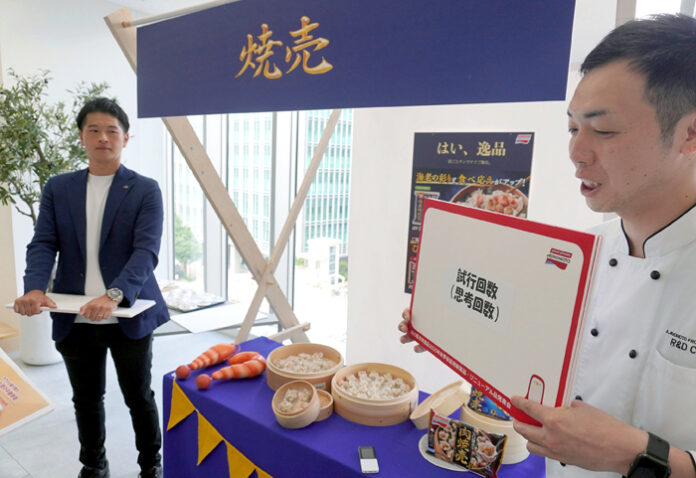AJINOMOTO FROZEN FOODS has released more than 10 new products and renewal products for the autumn sales season this year as well. This year’s product presentation (trial session) was different from usual, and for each new product, both marketing and developing person conveyed their real voices at the Marche, sharing their behind-the-scenes stories and passionate feelings.
President Hiroyuki Teramoto pointed out that “the frozen food market is strong, but that’s why there are many new entries and the competitive environment is severe.” “Many new products are released every season, but unfortunately they have repeatedly disappeared in a short period of time,” he said, adding, “As a company in the Ajinomoto Group, we want to deliver the development story and thoughts of products backed by technology and brand, along with the reason why consumers can pick them up.”
Hiroshi Sugita, Director and Managing Executive Officer, said, “The new products respond to environmental changes and diversifying needs, such as ‘To enjoy meals together with family,’ ‘To eat delicious food even alone,’ ‘To cook with good time performance,’ and ‘To eat health-conscious meals,’ and frozen foods are essential to meet these needs at once.
▼ “Koku Uma Miso Gyoza” = The company focused on miso that goes well with rice and pork as a gyoza (dumpling) filling. Based on the concept of gyoza that can be enjoyed by family, “It is a difficult theme to satisfy both children and adults, but in order to achieve both the sweetness that children can eat and the richness that adults will appreciate, we came up with ‘aged sweet miso'”. “It was the first time in the industry to use miso for filling, so it was quite a challenge. We tried about 20 types of miso, but I had a hard time with the amount of miso,” he recalls. The miso is made from aged sweet miso from Nagano Prefecture, but he says, “I ate at various restaurants before I arrived at Miso Gyoza, and I am looking forward to it because miso is familiar to Japanese people and goes well with rice.”
▼ “Nabe-ni Soup-ni Sui Gyoza” = “Gyoza skin does not melt easily, so it can be used in both nabe (hot-pot) and soup like an all-round player,” said the person in charge, who compares the new product to a baseball “new starting lineup” and has high expectations. “There are many tricky gyozas, but Sui Gyoza (boiled gyoza) is good-natured and gentle beings that goes well with everyone,” he says, revealing its rivalry with fried gyoza. In addition, general Sui Gyoza comes in 15 to 16 pieces per bag, but 24-piece bag is also emphasized because you can use as many as you want when you run out of ingredients in the nabe or when the soup is in a rut. The person in charge who was involved in the development for the first time also cleared the difficult task of “increasing the amount of filling, reducing the gyoza skin, and balancing the thickness of the skin with the amount of ingredients.”
▼ “Ebi Niku Shumai ” (Renewal) = Large Ebi (shrimp) is topped on the Niku (meat) Shumai to enhance the presence and color of the Ebi. The chewy texture of Ebi is highlighted, and the satisfying texture is also emphasized. “It is a simple task to top Ebi on shumai by hand, but due to industrialization, it is difficult to top a certain amount of Ebi in the middle of the shumai, and it took three years to finally realize it,” said the person in charge. It was made possible because of the passionate desire of the person in charge to “put more shumai on the table”. “Along with the texture of the Ebi, we were particular about the fun and gorgeous appearance,” he says.
▼ “XO Jan Kaoru Niku Shumai” = Bite-sized Niku (meat) Shumai that is perfect for side dishes such as bento boxes and snacks. The key point is that it comes in a bag of 15 pieces, and it can be used as a side dish, and the aroma of XO Jan (sauce) spreads out, making it delicious even when cold. “We struggled with how much we could increase the number of pieces under the condition that it would be included in the tray,” he said, “We repeated nearly 100 prototypes while considering the number of pieces, the selling price, and the dining scene.”

